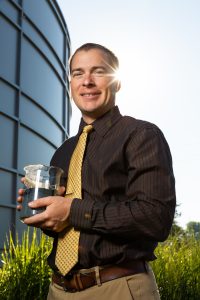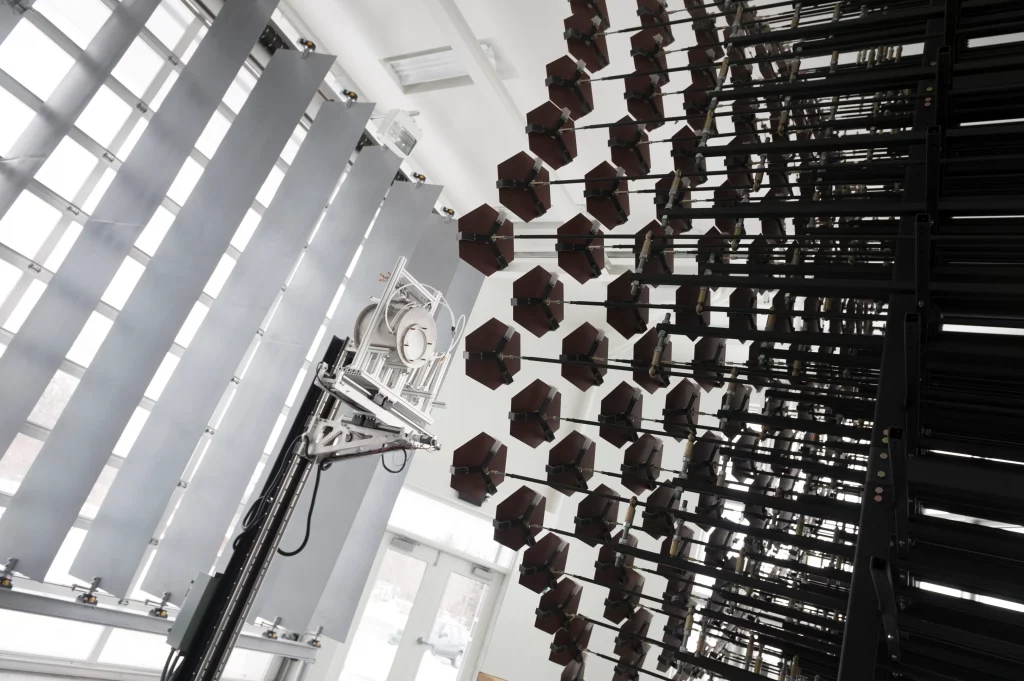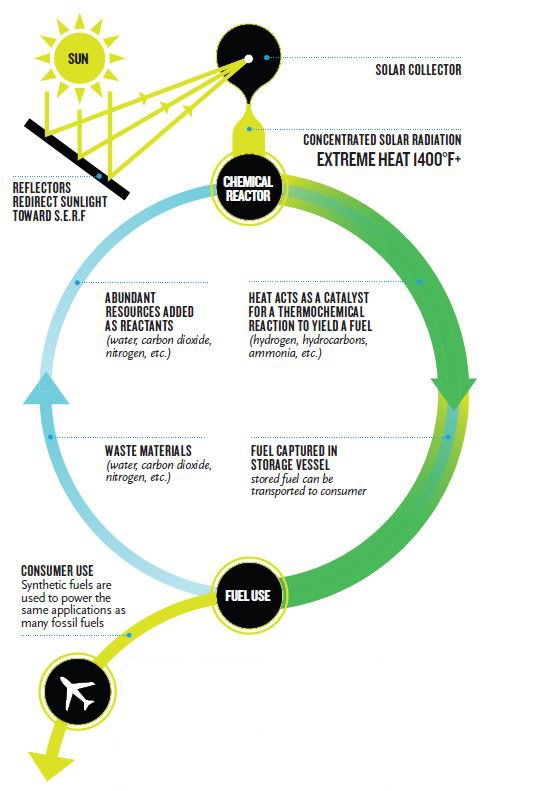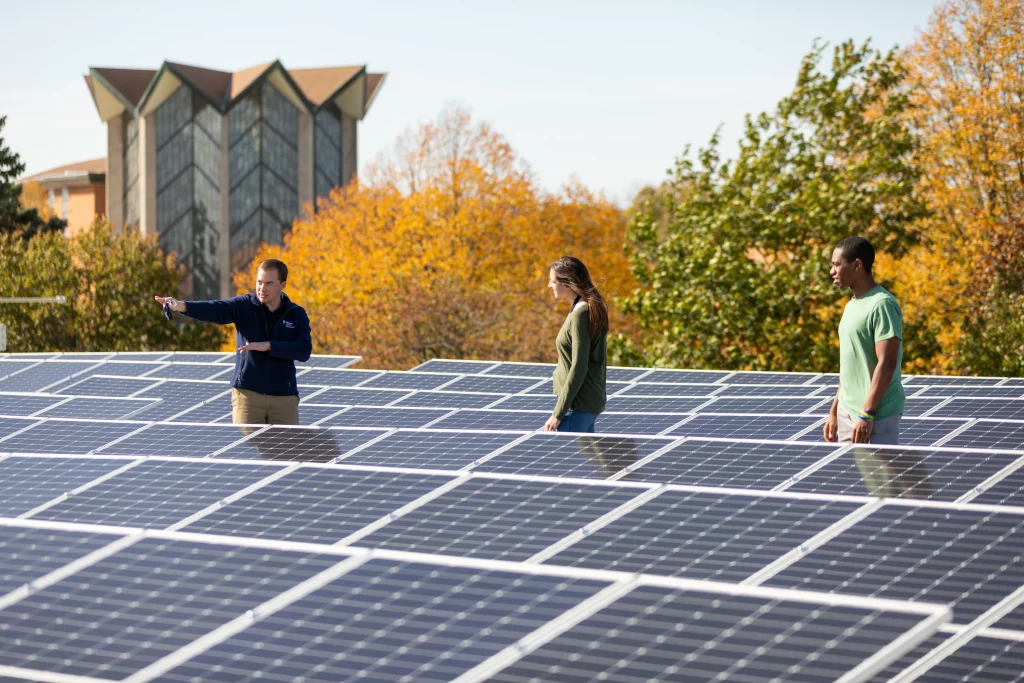Valparaiso University’s legacy of undergraduate research propels the next wave of energy independence.
With oil prices continuing to see major instability, the conversation around the country about renewable energy and going green has never been more prevalent. At Valparaiso University, students are receiving an unparalleled experience in real-world research at the James S. Markiewicz Solar Energy Research Facility, led in part by Luke Venstrom ’07, Ph.D., associate professor of mechanical engineering.
Professor Venstrom came to Valparaiso University in 2003 with the hopes of being a civil engineer. However, thanks to the College of Engineering’s dedication to giving all students the opportunity to explore multiple pathways, that would soon change.
“One of the goals of the Introduction to Engineering course is to expose students to all types of engineering,” Professor Venstrom says. “When I took the course as a student, I realized that civil engineering wasn’t for me and that I was much more interested in mechanical engineering.”
Professor Venstrom’s relationship with the faculty inspired him, especially Robert Palumbo, Ph.D., professor of mechanical engineering, whose passion for thermal science cemented his career trajectory.
“He showed me that solar energy was more than just photovoltaic (PV) panels,” Professor Venstrom says. “His work showed that we can think of solar energy as an energy input for producing fuels and commercial commodities.”
Professor Venstrom graduated from Valpo just as an exciting idea was taking shape on campus: the creation of the first solar research lab at a U.S. undergraduate institution. After he left Valparaiso to pursue graduate education, the project would gain more momentum through the generous support of James S. Markiewicz ’72.
Markiewicz is the founder of Capital Engineering and served as the company’s president from its start in 1984 until its sale in 2007. While he toured the Gellersen Engineering and Mathematics building with then-Dean of the College of Engineering Kraig Olejniczak ’87, Markiewicz was presented with a number of projects and initiatives that he might be interested in funding.
It wasn’t until they sat down in Dean Olejniczak’s office, where a solar furnace concept drawing sat leaning against the wall, that he found the project he could support. Markiewicz’s gift covered half of the more than $1 million project with the other half coming from a United States Department of Energy grant.
Having secured the funding needed to build the lab, the University and the College of Engineering had a choice: they could either contract the design out to a firm or make the lab a student project. Despite the additional time and hurdles of such a massive student undertaking, the chance to give students such an amazing opportunity could not be missed.
For most people, the idea of solar energy is inexorably linked with the mental image of panels of glass and metal on a rooftop or in a field, converting the sun’s rays into usable electricity. At the solar research facility, however, students learn that the potential uses of sunlight can be much more.
The solar furnace, an array of hexagonal mirrors hung in the air at precise angles, is capable of focusing sunlight into a concentrated area, the same way a magnifying glass can focus a sunbeam onto a leaf on a sunny day. In this instance, however, instead of generating enough heat to light a leaf on fire, the solar furnace concentrates sunlight into a focal point that can reach over 3,000 degrees Fahrenheit.
Creating that kind of facility was no mean feat, especially for undergraduate students. The first challenge was to create a system that would allow the focusing mirrors to be properly aligned.
“They were trying to hold mirrors fixed in space over very long periods of time,” Professor Venstrom says. “We have to have freedom of movement to focus them, but once they’re focused, we want them to stay put.”
Another problem arose from the sheer size of the solar furnace. As it stands, the focal point for all that solar energy stands ten feet off the ground, requiring a lifting mechanism. Lastly, a system was required to regulate the power in the system, allowing the users to lower or raise the amount of light coming into the furnace as-needed. All of these systems were designed by students as part of their senior design projects, coming together to form one of only five facilities with a solar furnace in the country, and the only solar lab of its kind at an undergraduate institution.
During this exciting time for the College of Engineering, Professor Venstrom was working on his master’s degree at the University of Minnesota. It was his experiences working on advanced degrees that sparked a passion for teaching.
PV panels are great for cars, but when you start thinking about flying cargo planes on electricity, I don’t know if that’s going to work … I look for ways to use solar energy to produce the fuel that our existing airplanes run on.
LUKE VENSTROM
“I went to graduate school thinking that all I wanted to do was spend my time researching the ideas Professor Polumbo showed me,” Professor Venstrom says. “I started to see the way that faculty at the institution viewed undergraduate education as a secondary thing. That was disappointing to me, so I asked for the opportunity to be a teaching assistant.”
Professor Venstrom’s experience in the classroom was enough to convince him that, in addition to conducting research, he wanted to share his knowledge and passion with engineering students. After obtaining his Ph.D. in mechanical engineering from the University of Minnesota, Professor Venstrom found himself going back to where his higher education experience all began.
“If there was to be such a thing as a dream position for me, Valpo is it,” Professor Venstrom says. “I wanted a school that placed an incredibly high value on undergraduate education in engineering. I also wanted to be able to keep doing concentrated solar energy research. Valpo is the only undergraduate program in the country that allows me to focus on both.”
As a researcher, Professor Venstrom works to create unique ways that we can utilize solar energy for everyday purposes. While the PV panels that have become synonymous with solar power have their place, according to Venstrom, his work looks further.
“PV panels are great for cars, but when you start thinking about flying cargo planes on electricity, I don’t know if that’s going to work,” Professor Venstrom says. “I look for ways to use solar energy to produce the fuel that our existing airplanes run on.”
By using common ingredients and solar power, Professor Venstrom’s work creates synthetic fuel, chemically identical to the diesel used today. The difference is that Professor Venstrom’s solar method takes only a fraction of the time it takes nature to accomplish the same task.
“What’s created are not fossil fuels at all,” Professor Venstrom says. “I’m producing the exact same chemical, but the ingredients are water, carbon dioxide, and sunlight.”
To complement his teaching and research, Professor Venstrom is a member of the American Society for Engineering Education (ASEE) and the International Solar Energy Society. During his 2019 sabbatical, Professor Venstrom had the opportunity to work with the top names in his field, taking a position as a visiting scientist at the Institute for Future Fuels at the German Aerospace Center in 2019.
“I spent a lot of time talking to people about where this particular niche is headed,” Professor Venstrom says. “Those experiences of getting to talk to people like that are really valuable.
Originally, a Valpo engineering student planned to join him in Germany in Spring 2020, a plan that was halted by the COVID-19 pandemic. While that specific opportunity was met with an unexpected roadblock, the program still opens a variety of pathways for students to further their experience in renewable energy. For those pointing toward graduate school, their applications are given a potent edge when they participate in research and co-author papers.
Kent Warren ’15, a Mission, Texas, native who came to Valpo for the opportunity to play football while earning his degree in mechanical engineering, pursued work at the Solar Energy Facility to gain experience while pursuing his athletic goals.
“Being part of the football team, pursuing an internship was challenging as I wanted to stay on campus for the team,” Kent says. “I reached out to Professor Scott Duncan and he offered me the opportunity to work as an undergraduate assistant to gain some experience.”
As a research assistant, Kent was responsible for a large amount of computerized numerical control (CNC) manufacturing, as well as developing the system for focusing the convex mirror apparatus. Thanks to his efforts and the efforts of his fellow students, the system’s solar energy input was increased by a factor of two. He then went on to assist with experiments in hydrogen production.
That experience as a research assistant would put Kent on the career path he followed after graduation. While he was offered a number of industrial positions, Kent chose to instead pursue his master’s degree and Ph.D. from the University of Florida. He is now working on postdoctoral research in Boulder, Colorado, researching applications of solar energy similar to what he studied at Valpo.
“I would not be working in this field had it not been for the introduction I had from my professors during my time at Valpo.” Kent says. “I always wanted to try to use the skills bestowed upon me for a greater purpose — using the talents I’ve been provided to benefit society in some positive way.”
In the summer of 2013, Jonathan Ogland-Hand ’14 worked in the Solar Research Facility on a project attempting to find a way to alter iron through heat in the solar furnace, then return it to its original chemical state.
“That experience was instrumental in launching me into a Ph.D. research program,” Jonathan says.
In graduate school at The Ohio State University, Jonathan shifted his research focus to environmental science policy, looking into the how outside factors influence the kind of innovation created at facilities like the Solar Research Facility.
“As an engineer, I could make whatever cool technology I wanted, but there is a lot of public policy that dictates how that technology will be adapted,” Jonathan says. “My experience in solar research inspired me to explore that more directly in graduate school.”
Today, Jonathan and his business partners are building their own company. Carbon Solutions LLC utilizes scientific expertise and innovative software to sequester carbon, remove it from the air, and store it underground, a step that Professor Venstrom says is needed to avoid the worst possible outcome for the planet. Jonathan believes that, as a for-profit company, his company is positioned to influence the development of carbon-neutral technologies and industry in ways that academic laboratories and government regulators can not.
“I felt very well prepared technically, and with soft skills through the organizations I was a part of at the University,” Jonathan says. “A lot of the foundational skills that made me successful, I contribute to things I started learning at Valpo.”
I think these companies might say that they think it’s great that projects like this will reduce carbon emissions in the world, but they’re not doing it for that. They’re doing it because they think it will make them money, and it will.”
LUKE VENSTROM
HOW S.E.R.F.’S SOLAR FURNACE HARNESSES THE POWER OF THE SUN
Systems like those in Valpo’s S.E.R.F utilize a thermochemical process to produce a stable liquid fuel. Raw materials are introduced to a chemical reactor and heated to extreme temperatures (in excess of 1,400 degrees) by precisely aimed reflectors capturing and redirecting sunlight into a collector. The result is a reaction capable of producing any number of storable and transportable fuels such as hydrocarbons or ammonia. Though synthetic, these solar fuels are chemically identical to other fuels like diesel, allowing them to be used in the same applications using the same infrastructure. As the solar fuel is spent, waste materials (carbon dioxide, water, nitrogen, etc.) are produced, which can be recaptured and recycled to once again fuel the thermochemical reactions. Start-up expense is a current obstacle to such systems, but once set up, this thermochemical process is theoretically an efficient process to produce fuel, and produces less waste and expends fewer resources when compared to fossil fuels. Most importantly, these systems emit no greenhouse gases. Valpo faculty and students are playing a pioneering role in one of the many promising paths towards opening a new future of energy production.
Samantha Kopping ’17 worked on creating computer models of the chemical reactions taking place inside the solar furnace. Her work led to her co-authoring with Professor Venstrom on a research paper that they presented at the 16th ASME Energy Sustainability Conference.
“Those experiences were great confidence boosters, letting me try to solve problems that no one has really looked at,” Samantha says. “It also helped my public speaking and ability to really address a topic in-depth.”
Samantha went on to the University of Minnesota for her master’s degree in mechanical engineering before going to work for Mortenson Construction, where she now works in their solar energy group. She is currently assigned to a massive solar farm and battery project in California’s Mojave Desert that will contain an estimated 2.5 million modules, 110,000 lithium battery modules, and will be capable of powering 260,000 homes.
Students entering the solar research field today will likely find plenty of opportunities post-graduation as well, with changing public and industry attitudes towards renewable energy raising the demand for trained professionals. According to Professor Venstrom, the cost of solar electric panels has decreased sharply, making it the cheapest source of new energy available. Current and upcoming projects in Northwest Indiana by NIPSCO and other entities are bringing a massive increase to the presence of solar energy to the region, though perhaps not totally due to environmental concerns.
“I think these companies might say that they think it’s great that projects like this will reduce carbon emissions in the world, but they’re not doing it for that. They’re doing it because they think it will make them money, and it will,” Professor Venstrom says. “The economics of solar energy is driving the market, and that’s good for us, because we need to work very quickly to avoid the worst consequences of climate change.”
Those consequences could include the acidification of the oceans, destruction of the coral reefs, and the extinction of various animal species unsuited to survive the new patterns.
While solar energy can be part of the solution towards avoiding these consequences, there are still technical hurdles to be overcome. One of the biggest challenges is making sure solar power is available where and when the consumer needs it.
“The problem is that you don’t care how cheap solar is when you want to turn on the light at 1 a.m.,” Professor Venstrom says. “If it’s not there, it’s not there.”
Likewise, utility companies already face the constant challenges of matching the electric power available to consumers with the demands of the community. The consequences of these variables not lining up were seen in Texas during the winter outages of 2021, as the grid struggled to keep up with the sudden demand for power.
New technologies to deal with some of these issues are on the horizon, with other options already available. Smart-grids and smart-devices in homes could allow those working at the grid to make minor adjustments on the demand side to avoid catastrophe, such as small adjustments to home air conditioning during peak power usage. Companies such as Form Energy are pioneering new methods of energy storage, allowing surplus solar energy to be squirreled away for the darker hours and seasons.
Finally, the work being done at Valparaiso University’s James S. Markiewicz Solar Energy Research Facility, with its unique approach of combining solar, thermodynamic, chemical, and electrical processes that could theoretically produce fuel is the niche in the research that makes the University a unique leader in the field.
“Our goal is to take an idea and make it industrially attractive,” Professor Venstrom says. “We are trying to move this idea to a place where we can say we’ve solved all the problems in the lab and show we can make it happen on a larger scale, that’s the idea we’re pushing towards.”
More than pushing the field academically, Professor Venstrom feels that the Solar Research Facility’s true strength is in the experts it helps create.
“Our students are out there on the front lines, doing the work that’s required to get solar energy deployed,” Professor Venstrom says. “Knowing that their time at Valpo put them on a path that got them there, that’s the impact Valpo has.”
Professor Venstrom and students examine part of the 75 kilowatt solar array on the roof of the Fites Innovation Center, part of the Gellerson Engineering and Mathematics building, connected directly to the building’s electrical meter. The array produces around 100,000 kilowatt hours of electricity every year on the low end, providing 10-20% of the over 13,000 square foot lab space’s overall energy use, estimated to be 600,000 kilowatt hours per year.





